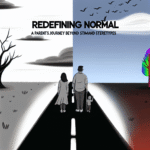
Grief’s Journey: Exploring Its Stages and Effective Coping Strategies for Healing and Growth
Introduction
Grief is an inevitable part of the human experience. It touches us all, in one form or another, whether through the loss of a loved one, the end of a significant relationship, or even the loss of a dream. If you’ve ever felt the earth-shattering weight of sorrow or found yourself drowning in an ocean of emotions, you’re not alone. Understanding "Grief’s Journey: Exploring Its Stages and Effective Coping Strategies" can empower you and others to navigate this challenging terrain.
In today’s fast-paced world, we often overlook the profound impact that grief can have on our lives. The struggle is real, and the pain is genuine. But there is hope, and each step on this journey can lead you to healing and growth. This article aims to provide insights, strategies, and pathways that can support you in your unique journey through grief.
The Stages of Grief
The concept of grief stages serves as a framework for understanding the complex emotions associated with loss. The most recognized model is the Kübler-Ross model, which outlines five stages: denial, anger, bargaining, depression, and acceptance. While this model provides clarity, it’s essential to remember that grief is not linear; individuals may experience these stages in different orders or revisit stages multiple times.
1. Denial
What It Is:
Denial serves as a protective mechanism, shielding us from the overwhelming reality of our loss. It can manifest as numbness or disbelief.
Case Study:
Sarah, who lost her father unexpectedly, first reacted with shock. She was unable to process the reality and went through the motions of planning the funeral while feeling detached.
Relevance:
Understanding denial helps individuals recognize that it’s a normal response. Sarah’s experience illustrates how grief can first present itself as emotional numbness, protecting her from immediate pain.
2. Anger
What It Is:
As denial fades, anger often takes its place. This anger can be directed towards others, oneself, or even the deceased.
Case Study:
Tom, facing the loss of his partner, initially felt furious. He raged not only at those around him but also at himself for not having done more to prevent the tragedy.
Relevance:
Tom’s experience underscores that acknowledging anger can be instrumental in moving forward. It points to the human desire to control events in an uncontrollable world.
3. Bargaining
What It Is:
Bargaining represents the struggle to regain control over the situation. It can involve thoughts like, “If only I had done this differently…”
Case Study:
Maya constantly replayed scenarios in her mind, thinking that if she had been with her mother during her illness, she could have somehow changed the outcome.
Relevance:
Maya’s case serves to illustrate that bargaining is a common phase where individuals try to make sense of their loss. Recognizing this can help one understand the need for closure.
4. Depression
What It Is:
Often considered the most profound stage, depression involves deep feelings of sadness and despair. This stage can be debilitating.
Case Study:
James, who lost his best friend, fell into a deep depression. This stage made it difficult for him to engage in daily activities, affecting his work and relationships.
Relevance:
Through James’s story, we gain insight into the severity of this phase. It highlights the necessity of seeking professional help, as navigating grief alone can lead to further complications.
5. Acceptance
What It Is:
Acceptance doesn’t mean forgetting the loss. Instead, it represents a new understanding of life post-loss. It is the integration of grief into one’s life.
Case Study:
Elena often reflects on her brother’s life, cherishing memories rather than focusing on the void. Over time, she found ways to honor his memory that have enriched her life.
Relevance:
Elena’s journey signifies the importance of acceptance in healing. It shows that while love endures, finding ways to carry that love forward can be empowering.
Effective Coping Strategies
Now that we’ve explored the stages of grief, it’s essential to equip ourselves with coping strategies that can provide relief and promote healing. Here are some proven techniques to navigate "Grief’s Journey: Exploring Its Stages and Effective Coping Strategies."
1. Seek Support
Explanation:
Connecting with others, whether friends, family, or support groups, provides an essential outlet for expressing emotions.
Practical Tip:
Consider joining a grief support group where individuals share their stories and experiences, creating a sense of camaraderie.
2. Practice Mindfulness
Explanation:
Mindfulness techniques can help ground individuals in the present, alleviating overwhelming emotions associated with the past.
Practical Tip:
Incorporate meditation or deep-breathing exercises into your daily routine. Apps like Headspace can guide you through this practice.
3. Express Yourself Creatively
Explanation:
Artistic expression can be a powerful tool for working through grief. It allows individuals to articulate feelings that may be too complex for words.
Practical Tip:
Try journaling about your feelings, painting, or engaging in music as a way to explore and process grief.
4. Establish Routines
Explanation:
Creating daily routines provides structure and a sense of normalcy, helping individuals regain a sense of control.
Practical Tip:
Set specific times for meals, exercise, and engaging in enjoyable activities. This predictability can be comforting.
5. Allow Yourself to Feel
Explanation:
Emotions are a natural part of the grieving process. It’s essential to allow yourself to feel sadness, anger, or any other emotions that arise.
Practical Tip:
Set aside time to reflect on your feelings in a safe, quiet space. Whether through writing or contemplation, embrace the emotions you experience.
6. Utilize Professional Help
Explanation:
Sometimes, professional guidance is necessary for navigating grief. Therapists or counselors specializing in grief can offer strategies tailored to individual needs.
Practical Tip:
Look for local therapists or online counseling services specializing in grief. It can be beneficial to have someone to talk to who understands the grieving process.
7. Create Rituals
Explanation:
Rituals can help honor a loved one’s memory and provide comfort during times of grief.
Practical Tip:
Consider establishing annual traditions, such as lighting a candle on special days or creating a scrapbook celebrating positive memories.
Case Studies: Real-World Applications of Coping Strategies
Case Study Overview
The following case studies illustrate how different individuals employed specific coping strategies on their "Grief’s Journey: Exploring Its Stages and Effective Coping Strategies."
| Name | Stage | Coping Strategy | Outcome |
|---|---|---|---|
| Sarah | Denial | Seek Support | Participated in a support group, which helped normalize her experiences. |
| Tom | Anger | Practice Mindfulness | Learned to channel anger through breathing techniques, easing his burden. |
| Maya | Bargaining | Express Yourself Creatively | Wrote letters to her mother, which helped process feelings of guilt. |
| James | Depression | Establish Routines | Resumed his love for running, which lifted his spirits and minimized isolation. |
| Elena | Acceptance | Create Rituals | Developed a yearly memorial event that helped her celebrate her brother’s life. |
Analysis of Case Studies
These case studies highlight the diverse ways individuals navigate grief, showcasing that while the journey may vary, effective strategies can foster healing. Each story resonates through shared experiences, making the principles discussed tangible and relatable.
Conclusion
Grief’s journey can feel insurmountable at times, yet understanding its stages and employing effective coping strategies can illuminate the path to healing. From denial to acceptance, recognizing where you are on this journey is crucial. As you explore "Grief’s Journey: Exploring Its Stages and Effective Coping Strategies," remember that heartache can pave the way for deep reflection and growth.
Embracing the process, seeking help, and allowing yourself to feel can significantly enrich your healing journey. While grief may never disappear completely, we have the power to transform the experience into a path toward resilience and profound connection. You are not alone on this journey, and there is light ahead.
FAQs
1. How long does grief last?
Grief is highly individual. It may last for months or even years. It’s essential to honor your timeline without judgment.
2. Is it normal to feel anger during grief?
Yes, anger is a common stage of grief. It’s essential to acknowledge it, as it can be a part of the healing process.
3. Should I avoid reminders of the deceased?
Avoidance may provide temporary relief, but facing memories can facilitate healing. It’s a personal choice, and you should proceed at your own pace.
4. Can grief affect my physical health?
Absolutely. Grief can manifest physically, leading to exhaustion, changes in appetite, and other health issues. It’s vital to monitor your well-being.
5. How do I know if I need professional help?
If your grief feels overwhelming, persistent, or interferes with daily life, consider seeking professional support. There’s no shame in asking for help.
In navigating "Grief’s Journey: Exploring Its Stages and Effective Coping Strategies," remember that while grief is a shared human experience, your journey is unique to you. Embrace it, seek support, and trust that healing is not just possible but can lead to newfound strength and understanding.















